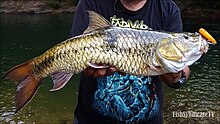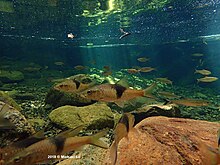| Hampala sabana | |
|---|---|

| |
| Conservation status | |
 Least Concern (IUCN 3.1) | |
| Scientific classification | |
| Domain: | Eukaryota |
| Kingdom: | Animalia |
| Phylum: | Chordata |
| Class: | Actinopterygii |
| Order: | Cypriniformes |
| Family: | Cyprinidae |
| Genus: | Hampala |
| Species: | H. sabana |
| Binomial name | |
| Hampala sabana Inger & P. K. Chin, 1962 | |
Hampala sabana is a species of cyprinid in the genus Hampala that is native to Malaysia
Description
This species reaches a maximum length of 41.0 centimetres (16.1 in) and has a distinctive single dark band below the dorsal fin similar to that of Barbodes sellifer. Although a second dark mark may develop at the base of the tail as it reaches maturity, with a dark line along the lateral line connecting the two marks. Depending on the habitat, the fins may be a light cream color or a dark orange-red.
Distribution and habitat
Endemic to the Malaysian state of Sabah, it is predominately found in the central-eastern region of the state in which it dominates its range from others of its genus.
The usual habitat of this species comprises clear and well-oxygenated running waters with substrates of sand, gravel, rock, or mud. Such habitats are usually tropical rainforest rivers and stream catchments but due to development these habitats are modified and converted to palm or rubber plantations, they can still survive in these habitats but in much lower abundance, making them rare
Ecology
As an active predator, it predominately feeds on other fish, frogs, and insects, preferring to inhabit deep and slower river stretches to ambush unsuspecting prey.

It's been observed to school together when young (even with other species like Rasbora sumatrana and Nematabramis everetii), and this behavior may possibly be continued throughout its life.
In the Segama river system, it has been found to live sympatricly with other species such as Luciosoma pellegrini, Nematabramis everetti, Garra borneensis, Gastromyzon lepidogaster, Mystus sabanus, and Pangasius tubbi.
References
- Lumbantobing, D. (2020). "Hampala sabana". IUCN Red List of Threatened Species. 2020: e.T91004261A91004368. doi:10.2305/IUCN.UK.2020-3.RLTS.T91004261A91004368.en. Retrieved 10 January 2025.
- ^ "Hampala sabana Inger & Chin, 1962". FishBase. Retrieved May 12, 2019.
- Ryan, Jeffrine R. J.; Esa, Yuzine B. (October 2006). "Phylogenetic Analysis of Hampala Fishes (Subfamily Cyprininae) in Malaysia Inferred from Partial Mitochondrial Cytochrome b DNA Sequences". Zoological Science. 23 (10): 893–901. doi:10.2108/zsj.23.893. ISSN 0289-0003. PMID 17116992.
- Rovie-Ryan, Jeffrine & Dennis, Kelvin & Esa, Yuzine & Adha, Khairul & Ibrahim, Zaidi & Ahmad, Zulkifli & E., Marilyn-Jaoi. (2008). NOTES ON HAMPALA (CYPRININAE) DISTRIBUTION FROM SIX LOCALITIES IN SABAH. Journal of Wildlife and Parks. 25. 29-32.
- Fishes of the Brantian drainage, Sabah, Malaysia, with description of a new Rasbora species (Teleostei: Cyprinidae).
- "The rainforests of Borneo & Southeast Asia". junglemikey.blogspot.com. Retrieved 2023-07-08.
- "Hampala sabana (Hampala macrolepidota sabana) — Seriously Fish". Retrieved 2023-07-08.
| Taxon identifiers | |
|---|---|
| Hampala sabana | |
This Cyprinidae-related article is a stub. You can help Misplaced Pages by expanding it. |